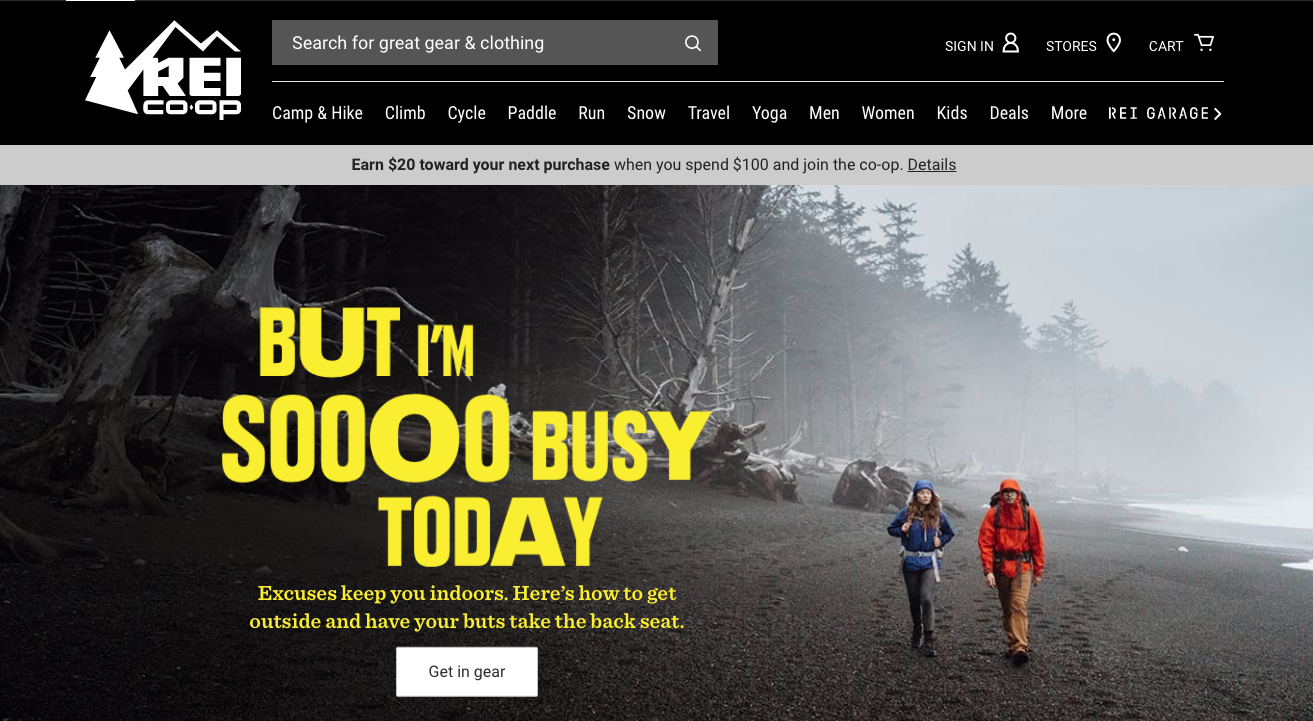![]() These days, everyone wants a piece of the Ecommerce action. I understand the temptation… There are many stories circulating about the demise of brick and mortar retail and the rise of ecommerce.
These days, everyone wants a piece of the Ecommerce action. I understand the temptation… There are many stories circulating about the demise of brick and mortar retail and the rise of ecommerce.
It’s a shiny penny that many can’t resist. But if brick and mortar retail is the heart of your brand, you better be careful when it comes to ecommerce.
First of all, the tales of retail armageddon are greatly exaggerated.
According to The Economist, less than 20% of all products sold in America in 2023 were sold through online retailers. So if you have a retail store, don’t give up. Eighty percent of all the stuff in the world is still being sold though brick and mortar stores, many of which are small, locally owned establishments.


According to The Atlantic, the retail industry isn’t dying, but it is at an inflection point. “Some brick-and-mortar retail brands with large footprints are struggling, while some e-commerce brands, like Warby Parker and Amazon, are now realizing the value of storefronts. Indeed, Amazon sees an uptick in online shopping in regions where it has a physical store, according to CNBC.”
So it goes both ways. More on retail industry branding.
One thing’s for sure… There’s an inevitable march toward the “bricks and clicks” model, where all retailers have elements of both ecommerce and traditional retail sales.
Here’s why: It feels better to buy from a real person. Simple as that.
We all appreciate the infinite information available online and the lazy-ass convenience of one-click buying, but it leaves us feeling empty. Unfulfilled. Vaguely dissatisfied when compared to traditional retail shopping.
So add a human touch wherever you can.
[convertkit form=5936283]
Which leads me to 4 common problems that arise when successful little retailers try their hand at ecommerce…
1. They forget what they’re really all about.
If you have a successful, specialty retail store, chances are you provide a fair amount of personalized service. You wouldn’t stay in business without it. For many of the retailers I know, that personal touch is a core element of their brand promise. That’s what they’re all about, and it’s impossible to duplicate that online.
Even if you devise the world’s greatest online shopping user interface, the shopping experience will always feel better in real life. So when it comes to ecommerce, your value proposition no longer applies.
2. They don’t differentiate their online store from the sea of competitors.
There’s a ton of competition in the wide, wide world of ecommerce, but very few companies do anything to differentiate their online store from all the rest.
It doesn’t make sense… They wouldn’t open a brick and mortar store that’s exactly the same as the store across the street, but that’s what they do online.
They use the same Ecommerce website template. They offer the same products for the same MAP price. They even use the exact same wording for the sales page of every product.
You can’t just cut and paste the same exact blurb, same photo and the same product specs and expect good results. You have to differentiate yourself somehow. You need to customize your pitch, improve your copy, and mix up the words a bit. You need to give people a reason to buy from you, instead of Amazon.
So how are you supposed to do that?
You could offer a unique mix of products. (Most niched e-commerce sites offer the exact same products as their competitors. But even if you could find something they don’t have, it’s not a sustainable advantage unless you have an exclusive arrangement with the manufacturer. So scratch that.)
You could offer lower pricing. (Actually, most MAP pricing agreements preclude you from doing that.)
You could use different technology. (There are many different back-end Ecommerce systems these days, and they all work pretty well. A good user interface is the cost of doing business in this space.)
You can have better content presented in your own, unique way, based on brand values that prospects will actually care about.
That, you can do! Learn how with this post.
3. They fail to see the difference between Ecommerce transactions and in-person sales.
Besides a ridiculously low price, what do online shoppers want? Information. Insight. And peace of mind.
Even if they’re ready to pull the trigger online shoppers want facts, reviews, articles or some kind of credible content that helps make the purchase decision a little bit easier. And quite often, they’ll go back to a website to get additional information, post-purchase. Just to help justify the decision in their own minds.
But amazingly few e-commerce sites actually fit the bill when it comes to informative content. Most offer no insight. No salesmanship. No differentiation whatsoever. They just regurgitate the manufacturer’s product spiel and hope for the best.
In fact, most online ecommerce sites aren’t really retail sites at all. They’re more like virtual warehouses.
If you want to establish a successful Ecommerce store you need to act like a real retailer, but in the online world. That means content marketing. That means sharp, convincing copy, and inspiring product stories. That means salesmanship.

Early in my career I wrote copy for Norm Thompson. Before J. Peterman ever became famous, Norm Thompson had a unique voice that resonated with its mature, upscale audience. We produced long, intelligent product pitches that went way beyond technical specs and pretty pictures.
For instance, I remember writing a full page spread on the optics of Serengetti Driver sunglasses. You could buy Serengetti’s in many different places, but no other sales outlet was as thorough as Norm Thompson.
Those spreads were helpful. Heroic. Practical. Luxurious. Readable. And convincing. It was the voice of the brand, and guess what? It worked.
The conversion rates and sales-to-page ratios of the Norm Thompson catalog were among the highest in the direct response industry. It’s tough to find anything remotely close in the on-line world. And unfortunately, Norm Thompson has failed to maintain that unique voice in the e-commerce arena. There’s no “Escape From the Ordinary” on their websites.
4. They’re not prepared for the added operational complexities of Ecommerce.
• There are technical issues galore… You better make sure that your POS system syncs seamlessly with your ecommerce platform. You’ll need a webmaster and someone to handle continual site updates as well as SEO, SEM and all the other components of digital marketing. You can easily get sucked into doing a lot of behind the scenes management that you’re not qualified for, and you really don’t enjoy.
• Labor costs will increase. You’ll need more help to get those orders filled and the website maintained. You have to run a pick, pack and ship operation out of the back of the store. So ask yourself this: Do you have the bandwidth for ecommerce? And will your traditional retail business suffer if you’re pulled in another direction?

I recently bought a new pair of hiking shoes. I could have purchased them online — I certainly did enough research — but I wanted the front-line opinion of a good shoe salesman. I wanted to talk with a human being, have a conversation and get a read on the three different shoes that I was considering.
Plus, I wanted to feel the difference. My feet are hard to fit, so I really need to try shoes on before I buy. So I went to the local REI and made a great purchase.
I trust that place. I love what the brand stands for. The salesmen know their shit. And REI’s site was a great source of information that started me on the path to purchase.
REI’s website was more credible than the manufacturer’s website, and it had better info on hiking shoes than Amazon or any other online resource that I could find.
The manufacturer’s brand and the local REI store both benefit from REI’s online presence and the REI brand ethos. The REI brand benefits from the expertise of its local salespeople to help close sales that started online.
That’s how it’s supposed to work! Bricks and clicks.
It’s a great model that can work for a big company like REI. But it’s not so easy for a small retail chain or an individual store. So before you start fishing for new customers through ecommerce, I’d suggest that you do some soul searching. First, define your brand. Then decide if ecommerce is going to boost your brand, or drag it down.
5. They don’t mind the Ecomm store like they do with their brick and mortar store.
All the business owners I’ve known who have small retail shops take great pride in the merchandising, design, lighting and overall appearance of their space. Every detail is painstakingly covered.
I cannot say the same for the ecommerce operators I’ve met. In fact, many don’t mind the store at all.
You have to dust the shelves, display the products, arrange related items and generally organize the entire ecommerce store just as you would a physical store.
Most people won’t even notice, but it’s those little details that can spell the difference between sustainable success and a quick flop.
If you’d like some real, evergreen content for your ecommerce website, give me a shout.




Its really a good piece of information